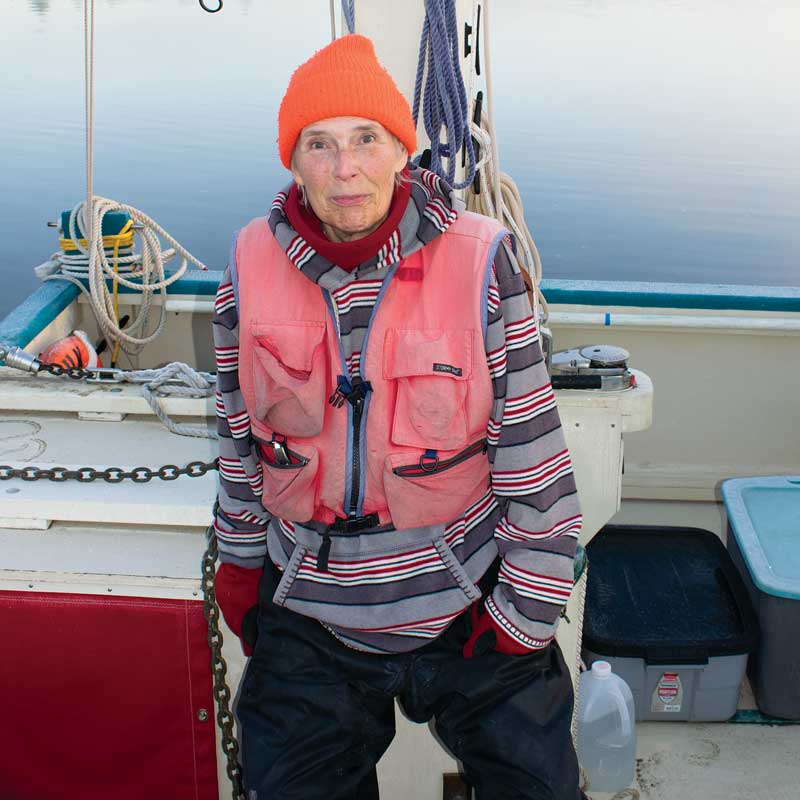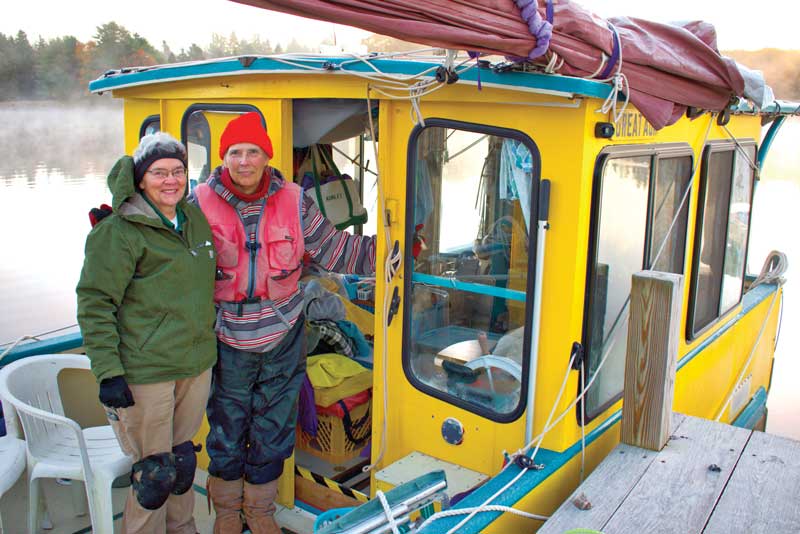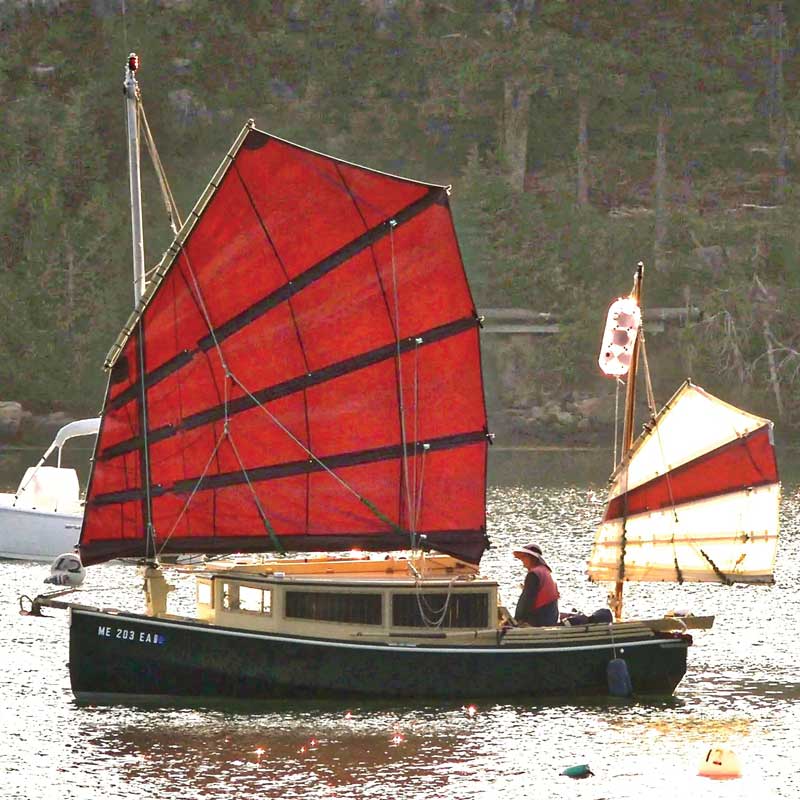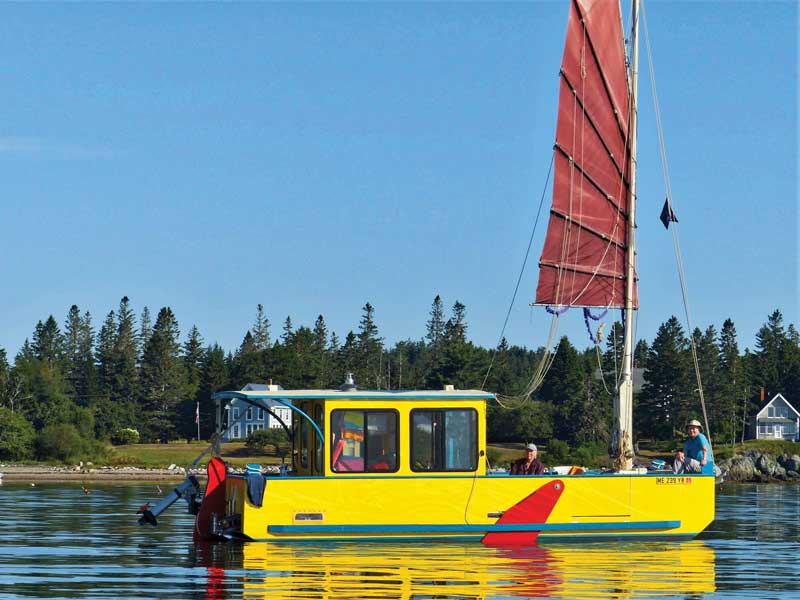“You know it’s big when the islands disappear behind the wave when you’re in the trough,” Gouldsboro sailor Shemaya Laurel wrote, describing the blow she encountered on a late-spring journey aboard her 24-foot sailing barge, Great Auk, on a cruise from her downeast home to the Pemaquid River in Muscongus Bay.
On that May morning, taking advantage of a brisk easterly breeze, the single-handed sailor took an exposed route outside the Muscle Ridge Islands. But the easing winds, forecast earlier that day, did the opposite. Turning at Two Bush Island, she reefed the flat-bottomed boat’s junk sail from inside the cabin. Then she sailed straight downwind toward Tenants Harbor, swinging into Long Cove.
“Because of the junk rig, and the halyard led into the cabin, it was easy enough to stay at the wheel for steering and also adjust the sail area, all in a very quick timeframe as I was blasting into the harbor entrance in the waves and making the turn,” Laurel recalled last autumn. She was sitting outdoors on the deck of her sage-gray clapboard home in Gouldsboro. “Not having crew, handling one or the other [line], was also made infinitely easier by the junk rig.”
Great Auk—Laurel’s latest coastal cruiser—is named for the now-extinct bird with penguin-like plumage that once abounded in the North Atlantic. It’s a Shanty T24 TriloBoat, designed by Alaskan boatbuilders Dave Zeiger and Anke Wagner, and it’s the latest in Laurel’s long line of watercraft dating back to a rowboat, which she dubbed about in as a child, in East Setauket, Long Island.
 Shemaya Laurel has put hours into devising ways of making her various boats simpler for a singlehander to manage. Photo by Letitia BaldwinThe box barge also is among four of the 67-year-old New Englander’s past and present craft that have been designed (or refit) with junk-rigged sails. The others include Auklet, a 20-foot Glass House Chebacco, designed by the late Gloucester, Massachusetts, naval architect Philip Bolger; a Peep Hen 14 microcruiser, Serenity, designed by Reuben Trane and built by Nimble Boat Works in Tampa, Florida; and Marigold, a 7-foot-8-inch Portland Pudgy dinghy, designed by David Hulbert of South Portland.
Shemaya Laurel has put hours into devising ways of making her various boats simpler for a singlehander to manage. Photo by Letitia BaldwinThe box barge also is among four of the 67-year-old New Englander’s past and present craft that have been designed (or refit) with junk-rigged sails. The others include Auklet, a 20-foot Glass House Chebacco, designed by the late Gloucester, Massachusetts, naval architect Philip Bolger; a Peep Hen 14 microcruiser, Serenity, designed by Reuben Trane and built by Nimble Boat Works in Tampa, Florida; and Marigold, a 7-foot-8-inch Portland Pudgy dinghy, designed by David Hulbert of South Portland.
For decades, Laurel has cruised, often solo, in coastal New England waters stretching from Long Island Sound to just short of the U.S.-Canada border. During that time, she’s explored how to lessen the physical demands of singlehanded sailing. That quest began aboard a Bristol Corsair 24 sloop, followed by a Falmouth Cutter 22 and the Peep Hen cruiser. Experience sailing those traditionally-rigged craft drew her to the junk rig that once dominated Southeast Asia’s seas and inland waterways, starting from the first century A.D.
Also referred to as a Chinese lugsail or sampan, the junk rig divides the sail—from luff to leech—into full-width, full-battened panels. Stress loads are spread equally to reduce strain across the sail area. Unlike the somewhat triangular Bermuda rig, the junk sails on her boats have been controlled by a system of sheetlets and blocks running from each panel’s battens along the cabin top, back to the cockpit. Like venetian blinds, individual panels are easily raised and lowered, and they drop neatly into lazy jacks.
In a strong breeze or squall, the junk sail is simple to reef without having to be bundled. Also, the sheeting system is designed to keep the sail a consistent shape to produce the aerodynamic force or lift that propels the boat forward.
British nautical expert and naval officer Herbert Warington Smyth praised the junk rig in his book Mast and Sail in Europe and Asia in 1906. “As an engine for carrying man and his commerce upon the high and stormy seas as well as on the vast inland waterways,” Warington Smyth wrote, “it is doubtful if any class of vessel is more suited or better adapted to its purpose than the Chinese or Indian junk, and it is certain that for flatness of sail and handiness, the Chinese rig is unsurpassed.”
Nowadays, cargo-bearing “junks” are far fewer, but still ply the waters of China, India, and other Southeast Asian nations. Even so, the ancient rig has never been widely embraced in the Western world. Critics contend that junks perform poorly upwind because their sails’ battened panels extend forward of the mast and disrupt airflow across the sail area.
Consequently, most sailmakers build camber—or curvature—into the junk sail’s panels. The sail’s rounded belly or pocket creates the forward thrust to drive the boat and improves its performance not only to windward but on all points of sail.
 Partners in life and boat rigging, Suzanne Jean (left) and Shemaya Laurel finish preparations for Laurel’s very early sail in her Shanty T24 TriloBoat in the spring of 2024 from Gouldsboro Bay. Photo by Letitia Baldwin
Partners in life and boat rigging, Suzanne Jean (left) and Shemaya Laurel finish preparations for Laurel’s very early sail in her Shanty T24 TriloBoat in the spring of 2024 from Gouldsboro Bay. Photo by Letitia Baldwin
“Full camber is a game changer as far as sailing upwind. I would not go without it again,” Laurel said. “There are arguments for people crossing oceans to stick with flat sails, but not for this kind of coastal sailing. But I had to prove it to myself, rather than just listening to practically everybody in the first place!”
Though somewhat of a rarity, Laurel is not alone in her preferences of sailing rigs. She has contributed many articles over the years to the Junk Rig Association, and previously served as the organization’s chair and sailing secretary. She also has organized two “junkets,” including one at her coastal Gouldsboro home about 39 miles east of Bar Harbor and Acadia National Park on Mount Desert Island. Over Labor Day weekend in 2018, five junk-rigged boats, ranging from a Mirror dinghy to a 39-foot modified ketch, spent much of the four-day convergence crisscrossing Gouldsboro and Joy bays. Feasting on fresh lobster and other Maine fare, the sailors swapped stories and technical info about their respective junks and experience sailing them.
“I had some fun tearing around in Marigold,” Laurel wrote in her September blog entry. She was showcasing the marigold-hued junk sail that she and her life partner, Suzanne Jean, fabricated on their deck and living room floor.
Easier reefing in strong winds motivated Laurel to put a junk rig aboard Marigold. Adjusting the dinghy-lifeboat’s Western-rigged sail previously had involved shortening the telescopic mast. Dropping the junk rig’s collapsible panels was easier.
“Once we had all the various pieces in order, we had a tremendous amount of fun rigging the whole thing in the living room. I could not be more pleased at the ease of working on such a small sailboat,” Laurel said in a blog post. “My fun seems to be magnified, the smaller the boats get. It’s easy, it’s lightweight, and something about raising the mast and sailing right there in the living room still makes me laugh.”
Celebrating their 25th anniversary in 2023, Laurel and Jean have laid hands together on at least six sailboats over the past 20 years. The two have built or adapted five junk-sail rigs to date. The first was the Chebacco-20 Auklet’s junk sail. Marigold’s conversion followed.
After moving to Gouldsboro in 2015, Laurel and Jean replaced a seasonal float and steel gangway a stone’s throw from their Joy Bay house. Laurel was able to literally sail away from home in Auklet, which she cruised in then. Before, they had trailered Auklet and other boats from their former home in Holyoke, Massachusetts.
Auklet fulfilled Laurel’s needs at the time. For years, she had cruised in a Peep Hen microcruiser along the Connecticut River to Long Island Sound, Narraganset Bay, and as far east as Kittery. Serenity performed well except in sudden gusts or shifting winds. Several times, such conditions nearly capsized the single-sail craft.
 Shemaya Laurel sails Auklet into Northeast Harbor in 2017. Photo by Suzanne Jean
Shemaya Laurel sails Auklet into Northeast Harbor in 2017. Photo by Suzanne Jean
Launched in the Connecticut River in 2012, Auklet is a sheet-plywood cat yawl whose designer, Phil Bolger, was inspired by the small, twin-masted fishing boats that originated in Massachusetts’s North Shore town of Essex. The high-sided vessel has a ballasted keel and a short mast and mizzen. Initially, it was rigged with a roller-reefing lug mainsail. Halyards and anchor line run to the roomy cockpit equipped with a tiller-style autopilot.
With many helping hands, Auklet took Laurel and Jean three years to finish off and rig in their Holyoke home’s driveway. When she finally set sail from Deep River, Connecticut, Laurel didn’t look back and spent almost seven months cruising and visiting friends and relatives around Long Island Sound and Narraganset Bay, and farther east to Buzzards, Casco and Penobscot bays.
One takeaway, though, was Laurel’s resolve to put a junk-rig on Auklet. Her research led to the British astronomer Vincent Reddish’s Chinese junk-rig sail plan. Reddish often cruised alone. Hindered by angina and back pain, he sought a rig that required less strength to handle.
Reddish, who served as the Astronomer Royal for Scotland, made a study of river- and ocean-going Chinese junks’ sails in retirement. He and his wife, Betty, then created a fan-shaped junk sail from a tarp on the lawn of their West Lothian home in Scotland. The luff was equally divided across the six-panel sail, which was framed by the yard, boom and five bamboo battens. In each panel, the leech’s length gradually increased up the sail.
Reddish tested the junk sail aboard his 17-foot Leisure cruiser. The astronomer’s project drew Laurel and other sailors to the Reddish sail plan.
“I sailed several hundred miles with this rig in the late summer of 1989, in winds varying from the lightest airs to the top of Force 6, gusting 7 [over 22 knots],” Reddish reported in a reprinted Practical Boat Owner article in 2022. “By which time, I was down to two panels and still thrashing fast to windward in great clouds of spray. In all respects, it outperforms the original Bermudian rig.”
Auklet’s conversion was Laurel and Jean’s first junk-rig. Holyoke, Massachusetts artist and friend Theo Fadel helped by making them scaled cardboard cutouts, mimicking the main and mizzen, in order to adapt Reddish’s sail plan.
“It was pretty entertaining. It felt like being a kid with paper dolls cut out from the Sunday newspaper, but way more fun!” Laurel said. The late Virginia sailmaker Stuart Hopkins of Dabbler Sails took the final drawing and built Auklet’s fanned main and mizzen.
On Auklet’s maiden voyage as a junk in 2014, Alaskan boatbuilder Dave Zeiger and Anke Wagner accompanied Laurel on a five-day leg from Gloucester to Plymouth, Massachusetts. Zeiger had recommended Reddish’s junk-rig because it worked with minimal camber and produced the most sail area on the shortest mast.
 Shemaya Laurel and Suzanne Jean (on the bow) take Great Auk for its inaugural sail off Gouldsboro in 2020. Photo by Bonnie Kane
Shemaya Laurel and Suzanne Jean (on the bow) take Great Auk for its inaugural sail off Gouldsboro in 2020. Photo by Bonnie Kane
“Shemaya has her vessel in hand. The boat and its every function have been scaled and adapted to her range of ability. She has sailed this summer over many miles of busy and challenging waters, with no more excitement than anyone would expect on such a voyage,” he observed. “Her seamanship is competent and business-like. Her stories lack the luster of danger or derring-do. She has tooled up in accordance with her constraints, and then simply gone sailing.”
For decades, Zeiger and Wagner have lived and cruised among the 1,100 islands in Southeast Alaska’s Alexander Archipelago. Their motorless sailboats have ranged from a shallow-draft Bolger Long Micro to a three-masted, junk-rigged schooner.
Zeiger’s boat designs include his current sailing barge Wayward, powered by two junk sails. It is his latest do-it-yourself sailing barge/scow hull design. Inexpensive and easy to build, his TriloBoats have performed well in Southeast Alaska’s challenging waters and conditions including substantive gales. The TriloBoats caught Laurel’s eye, and percolated in her mind, before she acquired a plan for what would become Great Auk.
Resembling a houseboat, Zeiger’s Shanty T24 TrioloBoat fits the solo sailor’s vision for her current more leisurely, comfortable cruising phase. She sought to eliminate tiller work
and the cabin-to-cockpit scramble among other things. She and West Cove Boat Yard owner Christopher Lariviere worked closely to fine tune the design plan before Great Auk was built at the Sorrento company overlooking Frenchman Bay.
Launched in 2020, Great Auk is a cheerful sight. The lemon-yellow sailing barge has turquoise trim and a big, fire-engine red rudder and matching leeboards, and a burgundy junk sail. The craft’s spacious foredeck is a safe, pleasant space for socializing.
Great Auk can access shallow, secluded coves, reaches and estuaries. The sailing barge goes aground smoothly on sandbars and mud. Its copper plate-sheathed bottom shields it from rock strikes.
Inside Great Auk, tall windows wrap around the pilothouse-style cabin. From the houseboat’s wheel-steering station aft, twin Torqeedo 4.0 electric outboards are operated. From the forward steering station, all the junk sail’s lines are controlled. On the cabin top, solar panels power the motors’ batteries. The carbon mast is held in a winch-operated tabernacle on the foredeck. When lowered, the mast folds down, allowing passage under bridges.
In a good breeze, sailing downwind or on a broad reach, Great Auk will sail 4 to 4.5 knots.
“The boat will go 5, but things start to feel strained, on both rigging and steering,” Laurel said. “It makes more sense to reef (or reef more) and take the pressure off.”
Sailing to windward remained challenging. Great Auk still would only sail well upwind when it was dead calm and with some current. But the Shanty T24 got a literal “lift” during the 2024 sailing season. Laurel and Jean’s hands were busy making the yard and rigging myriad lines on a new, larger Reddish junk sail. Camber was increased in the sail built by German sailmakers Segelmacherei Tuchwerkstatt in the northeastern port of Greifswald.
The quest for the optimum sail plan goes on.
“Fifth junk-rigging job,” Laurel noted cheerfully.
✮
Letitia Baldwin is a freelance writer who lives in the downeast towns of Gouldsboro and Cranberry Isles. She previously worked as the Arts & Leisure Editor at The Ellsworth American and style editor at the Bangor Daily News.
To learn more about Shemaya Laurel visit sailingauklet.com.







